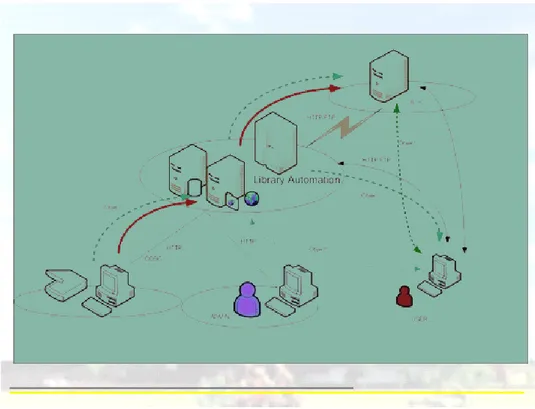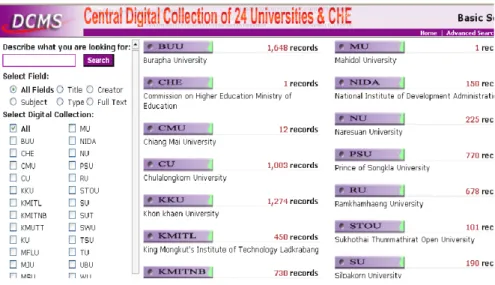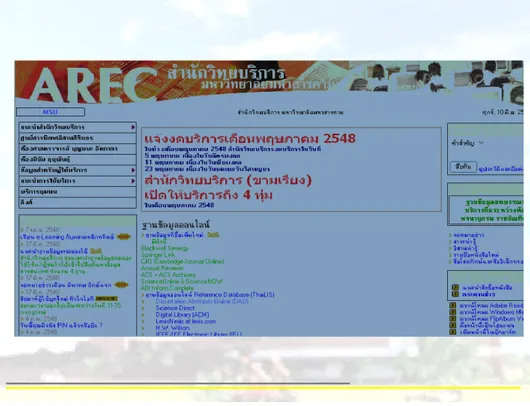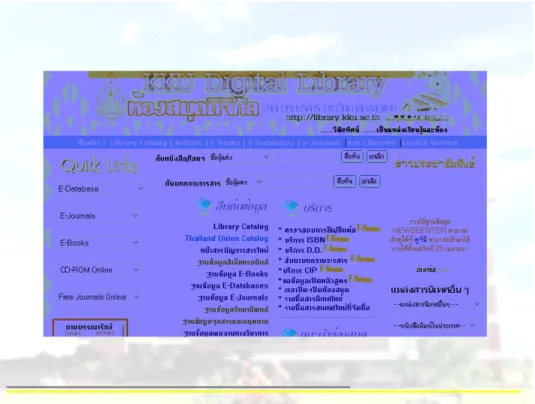Digital Library : A Transition for Academic Libraries
in Thailand
Sujin Butdisuwan
Faculty of Informatics
Mahasarakham University,
Thailand
Abstract
In Thailand, a library has existed for a long time but modern libraries were believed to start in 1954 when the Fulbright scholar, Dr. Francis Lander Spain, launched formal library training at Chulalongkorn University. That was the starting point for the Thai library systems. Since then, the Thai libraries gradually developed.
In the late 1970s, there was a tremendous transition for the library again when information technology and automated library systems were introduced to the Thai library communities. Major traditional libraries particularly the academic libraries turned to electronic or digital libraries and offered information services without boundaries. The library users can access library resources from anywhere at any time. The changing face of the library services leads to life-long learning environment and toward the learning society.
This paper addresses an overview of the Thai library systems, the academic libraries in particular and chronological background information of digital library initiatives that have been implemented in Thailand. Some examples are illustrated.
An overview of library systems in Thailand
Libraries have existed in Thailand since the thirteenth century. Until the mid-nineteenth century, most libraries were either in temples or royal courts. Modern libraries were introduced into the country in 1950s when Thailand began to open its doors to western influences and trades.
The Thai libraries, like any other libraries in the world, play a major role in providing information, education and knowledge to the society. They also act as a cultural and recreational center, and as a life-long learning center. There are five types of libraries, namely public library, school library, academic library, special library, and the National Library. Each type of libraries has its own ways to collect, organize, and preserve materials collected for the information needs of its users. However, all types of libraries have some similarities. In terms of materials collected, there are two major types: print and non-print materials. Electronic books and digital images are increasingly collected and obtained by most libraries. Some libraries may collect manuscripts, stone inscriptions, and other formats as well. The libraries obtain their information resources through purchase, subscription, exchange, donation, and self -development. The two major classification systems are Dewey Decimal
Classification Scheme and the Library of Congress Classification System. NLM and UDC are used in some libraries.
Due to the advancement of technology, some libraries especially academic and special libraries have turned from traditional libraries into automated or digital ones that allow them to collect, organize, process and distribute information resources electronically.
Academic Libraries
The term “academic libraries” here represents all libraries of higher education institutions or the university libraries. These include about 80 public and 26 private universities. In general, the academic libraries are much more developed than other types of libraries. Most academic libraries, especially university libraries, receive substantial funds from the government or their parent institutions. Their status in the organization is well-recognized, with most university libraries enjoying a status of academic ranking, while academic librarians are well qualified, with some holding a master’s and doctoral degrees from overseas.
With the advent of modern technologies, the academic libraries are among the first group that adopted the information and communication technology in the library. Computer applications can be seen in all university libraries and some college
libraries. Automated Library Systems such as INNOPAC, DYNIX, VTLS, and TINLIB are used. Due to the application of computers and communication
technology, library information networks and websites are created. Examples of the networks are Pulinet, Thailinet(M), Uni-Net, and ThaiLIS. The library networks allow the academic libraries to have closer links among themselves with the aim of sharing their resources through their inter-library loan services and the Internet.
Most academic libraries have created their own databases. At present, they have also created their own web sites, which assist users to gain access to their in-house databases, library information, and to be able to link to web-based information nationally and internationally. Commercial electronic resources such as books, e-journals, and online databases have been purchased in order to increase their service quality. The Thai University E-Books Consortium has also been established recently.
The library in transition
It is interesting to note that it took about three decades to transform the traditional libraries to “the digital libraries.” The following is key chronological background information showing the development of “digital libraries” in Thailand.
In 1975 the Asian Institute of Technology library began to use the mini CDS/ISIS software to create its bibliographic records. This stimulated other libraries to be aware of an exploitation of computer technology in library works. Some years later, more than 20 university libraries also used the software to create their own bibliographic databases. The union list of serials in Thailand was also created using the CDS/ISIS software during these days.
During 1983 to1985, Chiang Mai University Library got a support from the IDP, Australia to undertake a feasibility study for implementing library automation and creating library network for the region.
In 1985 Chulalongkorn University utilized the Innovative software and set up Chulalinet, the in-house library network, connecting the central library with faculty libraries.
In 1990 Chiang Mai University Library utilized the SEA-URICA library system but changed to the Innopac some years later.
In 1992 the National Electronics and Computer Technology Center
(ThaiSarn) with the aim to create scientific information databases and networks. The NECTEC provided financial support to the university libraries to acquire computer technology and computer networks in order to develop scientific and technological information databases. This has been another major turning point to the Thai library network. The academic libraries under the ThaiSarn project were able to share information and became networked.
During 1995 to 1997, there was another big transition for the Thai library systems. The regional networks, Pulinet and Thailinet (M), were set up. The Pulinet is the library network for provincial university libraries, whereas the Thailinet (M) is the library network for the university libraries located in the Bangkok Metropolitan areas. The Thai government allocated big money to the libraries. Then most academic libraries were able to purchase automated library systems. The most popular one was Innopac while some libraries used Dynix, VTLS, and TINLIB software. With the automated systems, the libraries gradually moved into “electronic libraries.” In addition, the Internet is widely used among the libraries. Online
information services have been recognized as major services in the libraries. Some new initiatives including digital libraries have been created.
The Inter-University Network (Uni-Net) is another project initiated by the Ministry of University Affairs that allows all academic libraries to have access to the information as well as databases in the designated libraries.
In 1998, The Pulinet and the Thailinet(M) merged and formed the Thai Library Integrated System (ThaiLIS). The new network aimed at providing one complete search with one access. It also stimulates the libraries to move toward electronic or digital library. To reach that goal, digital collection, electronic document delivery, and union catalog have been developed.
During 2000 to 2002, the Commission of Higher Education Office became a headquarter for ThaiLIS. It purchased e-books and online databases for all academic libraries to share the resources. It also launched the central digital library initiative along with union catalog and document delivery services projects. It is hoped that when these projects are completed, the libraries will be a true means for life-long learning in the Thai society.
The Digital Library Initiatives
The digital library concept has come to the Thai library communities when electronic resources increase and come to the library through the Internet in an era of the globalization. So the library is inevitable to be digital. Each individual academic library prepared to be digital by creating its in-house digital collections such as students’ theses, university archives, instructors’ manuals and research papers.
Besides, the library subscribed and purchased commercial digital resources such as e-books, e-journals, online databases, and CD-ROMs on various subjects.
It is interesting to note that a library consortium has been talked for many years in Thailand but it never happens. Just recently, a group of Pulinet libraries finally formed an e-book consortium entitled Thai University E-Books Consortium. There are about 3,000 e-books purchased from OCLC NetLibrary. The Commission of Higher Education also purchased about 5,000 e-books NetLibrary that all academic library users can have access to. So in total, there are about 8,000 e-books available for the users. Some libraries also subscribed to e-books from some other venders, ebrary for example.
The Digital Library Project
This project is launched by the Commission of Higher Education (CHE) which is located in Bangkok. The major goal of this project is to encourage all academic libraries to develop digital collections which include students’ theses, research papers, journals, rare books, media on demand, and archives and to facilitate resource sharing among the libraries. The CHE acts as a central site for the libraries. Each library creates its own digital collection and sends to the central site where the digital collection management software (DCMS) is developed. In doing so, the CHE provides necessary tools such as computer workstations and servers and scanners to the libraries. At this stage, there are 24 public university libraries under this project.
Figure 2: web page of 24 digital libraries
The Changing face of library services
The digital library is a real change for library services in Thailand at the moment. It is timely to transform the library into digital. Due to the Educational Acts and the Thai Constitution, the State should provide learning resources to facilitate life-long learning. Thai people should be able to access these resources regardless of time and places. Being digital, the libraries are able to provide web-based services and full-texts proactively. The libraries are also able to share resources particularly when money is a matter. This is a true value added to the library.
Problems
Although the digital library initiative is going well, some problems still exist. The followings are selected problems to be addressed.
Copyright issue is a big concern among libraries. All documents are owned by each institution. However, when the documents are put on the web and accessed virtually, the users may not be aware of the copyrights and illegally make copies out of it.
Connection and network is another problem. The communication system is not as stable as it should be. It is sometimes on and off that causes inconvenience to the users. Then the users may turn away and be reluctant to use.
A small scale of the users may have benefits from the digital libraries. They may access to the digital libraries from their houses or their offices. However, the majority may not be able to do that due to lack of understanding how to use or how to access. In addition, the users may not get used to it. They feel that it may not be convenient and comfortable reading from the screen as it is from monographs. This is due to their cultures and behaviors. Some users may have language barriers since
most digital resources including e-books, e-journals, online databases, and Internet resources are in English.
Conclusion
In conclusion, it is fair to say that all academic libraries in Thailand have been through the digitization processes and are going into the digital arena which means that they are ready to serve as learning resources for the new generation. Yet it is still along way to go in order to fully exploit from them and to serve the whole nation. There is still a lot of work ahead of us to make it possible.
Example of the digital library initiatives
The Academic Resource Center (AREC) serves as a university resources center for Mahasarakham University. Its potential users are students, faculty staff, and all university personnel. The Center has substantial collections, including books, periodicals, newspapers, pamphlets, clippings, research reports, theses, pictures, manuscripts, gramophones, records, compact discs, magnetic tapes, video tapes, and microfilms and microfiches.
In 1995 the Center automated its library system using the INNOPAC software. Bibliographic records of all materials were organized, processed, stored, and retrieved by using this software. Due to the vision of the Center which states as “providing first class information services by ordinary means or through computer networks, and acting as an information resource center, a database clearing house, and a place of recreation,” and with an advancement of the information technology, the Center has initiated the Digital Book Project: a Web-based full-text service in 1999. This project aims not only at transforming selected collections into digital formats, but also at developing the traditional library and information services in order to make it accessible via national and international networks.
The goals of the project are as follows:
1) to reorganize and digitize the collections published by/under the university such as students’ theses, research papers and texts written by university lecturers and professors and university archives;
2) to improve access to the repository through networks; 3) to enable better use and preservation of unique materials;
4) to facilitate national and international collaboration in research and training.
To undertake the project, the AREC prioritizes the documents to be transformed into the digital formats. These include students’ theses, textbooks or documents written/published or own by the university personnel, and the university archives. All selected texts are scanned and converted into the PDF formats using an acrobat software. The scanned texts are stored on the library server. Then
bibliographic records, bookmarks and links are created. Viewer software for local use is developed in the library, and browsers such as Netscape Navigator and Microsoft Internet Explorer can be used. Finally, all digital books are available via the library’s web server for public access.
Figure 3 Mahasarakham University Library Website
Figure 5 Khon Kaen University Library Website
Bibliography
Chirawan Bhakdibutr and Sutunnee Keesiri. “University Libraries in Thailand,” in Libraries and Librarianship in Thailand : From stones inscription to
microchips. Pp. 17-21. Bangkok: IFLA’99 National Organizing Committee, 1999.
Maenmas Chavalit, Khunying . “Libraries in Thailand : General Scenario,” in Libraries and Librarianship in Thailand : From stones inscription to
microchips. Pp. 1-2. Bangkok: IFLA’99 National Organizing Committee, 1999.
Prapavadee Suebsonthi and Nonglak Mainaikit. “ Thailand, Libraries and
Librarianship in,” in Encyclopedia of Library and Information Science. Ed. By Allen Kent. Vol. 43. New York : Dekker, 1988.
Wisit Chintawong. “Academic Libraries in Thailand,” in Introduction to ASEAN Librarianship : Academic Libraries. Pp. 107 – 120. Jakarta: The ASEAN Committee on Culture and Information, 1993.
Sompit Khusripitak. Library Automation Systems and Academic Libraries Network in Thailand. Bangkok : National Electronics and Computer Technology Center, 1994. (in Thai)
Thai Library Integrated System (ThaiLis). Bangkok : Office of Higher Education Standards. Ministry of University Affairs, 1998.
About the author
Sujin Butdisuwan is currently Dean of Faculty of Informatics, Mahasarakham University, Thailand. He was former Director of the Academic Resource Center at the same university. He has been with the Division of Library and Information Science since 1983 and has been involved in various professional activities including the 65th IFLA Conference in Bangkok, 1999 and the IFLA Satellite Meeting held in Khonkaen, 1999.
He was Head of the LIS Department during 1990-1998. He received M.A. in Library Science from Chulalongkorn University and Ph.D. in Educational
Adminstration from Illinois State University, USA.
His areas of interest include effective library management, strategic planning, quality assurance, digital library, performance measurement, information services to the disadvantaged persons, and research in the field of LIS.
Address: Faculty of Informatics, Mahasarakham University, Kantarawichai District, Mahasarakham 44150. Phone: 66-43-754359, Fax.: 66-43-754359, Email:



